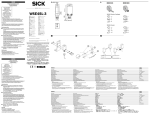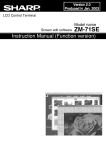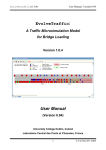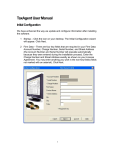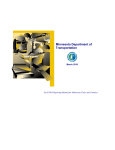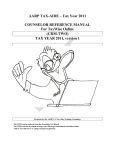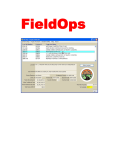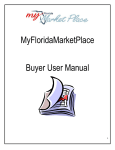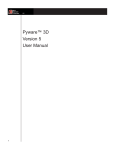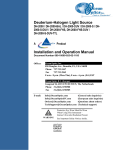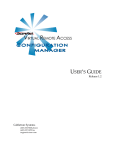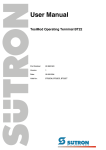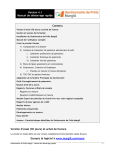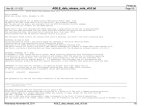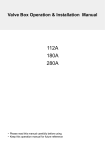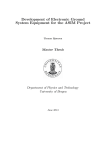Download 608.3 Sample Manual - Town of Superior
Transcript
TABLE OF CONTENTS INTRODUCTION BUDGET PROCESS MONTHLY BANK RECONCILIATION JOURNAL VOUCHERS MONTHLY FINANCIAL REPORTS YEAR END ACCOUNTING PROCEDURES ANNUAL REPORT AUDIT PREPARATION INVESTMENTS REPORT TO TOWN COUNCIL PAYROLL PAYROLL REPORTS INSURANCE ACCOUNTS PAYABLE (CLAIMS) REVENUE (RECEIPTS) UTILITY FIXED ASSETS LICENSES SWIMMING POOL CEMETERY VOLUNTEER FIRE RELIEF ASSOCIATION SPECIAL ASSESSMENT DISTRICTS SPECIAL IMPROVEMENT DISTRICTS DEBT MANAGEMENT INTRODUCTION This Manual describes in detail all of the policies and procedures for the operation of the Office of the Town Clerk/Treasurer. It is intended to provide current and future employees a basic working knowledge of all the activities of that Office. It is also intended provide information for policy-makers, other staff, and the general public on the workings of the Office. This is part of a larger effort to ensure the development and maintenance of an open and transparent government in the Town of Superior. In addition to descriptions of the processes of the Clerk/Treasurer’s Office, an attempt has been made to provide a rationale for each of the procedures described. Date: NOTE: SEE BLACK MOUNTAIN SOFTWARE MANUALS FOR DETAILED INSTRUCTIONS FOR FINANCE, FIXED ASSETS AND UTITLITY BILLING. THE MANUALS SHOULD BE PRINTED AT LEAST ONE TIME PER YEAR AND PLACED IN THE PROCEDURES MANUAL. BUDGET PROCESS Introduction The development and implementation of the Town’s annual budget is arguably the most important thing that the Town does. This is so because it provides the revenue sources and annual allocation for all the activities of the Town. In doing so it also creates an annual plan of action. The Town’s elected officials and staff work together to develop priorities and plans for Town operations in the coming year. This section includes a step-by-step process for the development of the Annual Town Budget. Budget Calendar Develop Budget Calendar, by December 1 – with deadlines for preliminary budget, and keeping in mind the statutory deadline (MCA 15-10-202). The Town can request an estimate of taxable value from the Department of Revenue by the second Monday in July. However, the Department of Revenue is not required to certify the mill value until the first Monday in August. State law requires that the final budget must be adopted by the second Monday in August, or 45 days after receipt of the certified mill value. Preliminary Payroll Worksheets Prepare preliminary payroll worksheets in Excel Update the pay matrix Worksheet in Excel Create new worksheets for payroll in Excel, by department, from old worksheets Budget Worksheets Prepare budget worksheets and distribute to department heads. Include Capital Outlay worksheets, and preliminary salary worksheets. Budget Estimates Tabulate and enter the budget estimates from department heads for the operation and maintenance functions (#200’s through 900’s) into preliminary budget worksheets. Also, enter the preliminary payroll information determined from the Excel worksheets. Expenditure estimates are based on previous year’s expenditures, and any changes such as rate increases, fee increases, raises, additional capital outlay, etc. Revenue Estimation Prepare revenue estimates based on last year’s revenues, and any changes in revenue structures planned for the year, such as rate increases, fee increases, anticipated loans, grants, or other one-time revenue sources. 1. Tax revenues are calculated using the worksheet and formulas designed by the Department of Administration, Local Government Services Division. The worksheet will be made available from the state on the web when it is ready, usually in June. Typically, the tax revenues are the last to be calculated. 2. Special assessment revenues from the Street Light District are based on the taxable valuation of property located in the district. The Town limits are the boundaries of the street lighting district. Real Estate and Mobile Homes are assessed the special assessment. Tax Schedules Summary Once all the appropriations and revenues have been estimated, then the information needs to be transferred to the Tax Schedules Summary sheets on a per fund basis. Refer to the prior year schedules for guidance. Year-End Journal Entries The cash balance as of June 30th is vital to the Summary Schedules. As soon after June 30th as possible, prepare the year-end journal entries that effect Revenues, Expenditures, and Cash. When all of the information is put into the schedules, the cash reserves are calculated, and cannot exceed 50% of the appropriation per statute. If they do, then the usual remedy is to increase the appropriation. Preliminary Budget to Council The preliminary budget is presented to council on the date determined by the Budget Calendar. Public Hearing Notices then have to be published twice prior to the Public Hearing for the budget. The Public Hearing must be held prior to final adoption of the budget, and can be continued from one council meeting to the next, or a special council meeting can be called. The Town usually holds the public budget hearing the first Wednesday of August. Council Approval of Final Budget The council then passes the Final Budget at a regular or special council meeting. Three resolutions must be prepared in order to do this. Consult the prior year’s documents for guidance. By statute, this must all be completed by the second Monday in August, or 45 days after receiving the certified taxable values from the state. Submit Budget to State The Final Budget Document must be submitted to the Montana Department of Administration, Local Government Services Bureau by October 1st or within 60 days of receiving the certified taxable values from the state. Consult the prior year’s document for guidance. MONTHLY BANK RECONCILIATION Balance Bank Deposit Tickets to Receipts Posted 1. Total deposit tickets, add any deposits in transit and direct deposits, subtract NSF checks, subtract last month’s deposit(s) in transit. 2. Run cash receipt summary (go to reports, go to trans, go to revenue vouchers reports, go to revenue/tax voucher, print. 3. The total of description 1. and the total of description 2. will balance. Reconciliation 1. Make sure all receipts have been posted. 2. Make sure all journal vouchers have been posted. 3. Check Redeeming Process See Black Mountain Finance manual for detailed procedures 4. In Finance Program go to reports, go to cash reports, go to cash/bank reconciliation. Fill in the blanks. The PERS electronic check is outstanding and is entered as a negative number. The bank statement balance includes the regular checking account and the MMIA account, less the interest amount. Occasionally a transfer between the two accounts will cause an transfer in transit. Interest Breakdown 1. Use the cash report from the cash reconciliation for the MMIA interest breakdown. The funds that receive a percentage of the MMIA interest are General (1000), Sewer (5310), Water (5210), SID Street Lighting (2400), CIF (4000), CIF-Fire Dept (4020), CIF Gas Tax (4050), Street Fund (2820). The percentage of interest for each fund is based on the funds balance in the MMIA account, which changes each month. To calculate the percentage take the ending balance for each fund subtract other investments or petty cash, total the balances, divide each fund balance by the total. The general fund includes other small funds not listed specifically above. Set up the percentages in the interest types in finance (go to Codes, go to interest types, click on MMIA, save). Do an interest allocation document in Finance, enter interest type (MMIA) and amount. Post MMIA interest, journal voucher, in Finance. 2. STIP (State Investment Pool) interest is split 2/3 to General Fund (1000) and 1/3 to Sewer Fund (5310). The percentages have already been set in the Interest types and do not change monthly. 3. Certificates of Deposit interest is receipted as they are received. The interest is posted to the appropriate fund which provided the funds for the investment. A manual receipt is written. Post the interest to cash receipts in Finance. JOURNAL VOUCHERS Certain monthly, quarterly and annual transactions can only be done by a manual Journal Voucher. These typically pertain to transfers to reserves, bank charges, or other charges, corrections and transfers. Water/Sewer Transfers Review the previous month’s JV. In July and January determine the monthly transfer amount for debt service. In July review the allocation for replacement and depreciation, this voucher can be done monthly, quarterly or annually. Bank Charges A Journal voucher is need for bank charges and fees. The monthly service charges, wire fees, etc. are found on the bank statements. Correcting Entry Errors Other Journal Vouchers are needed for correcting entries that were input in error. These are normally found through reconciliation procedures, and through review of the initial Revenue and Expense reports done at the end of the month. Interest Allocation Interest earned is allocated to the fund that provides the funds for investment. An Interest Allocation voucher is prepared and posted in finance. These are done monthly. Property Taxes and Assessment Charges Once a year, a Tax Voucher is prepared to record the Town’s property taxes and assessment charges. These figures originate from the Town, are transmitted to the county treasurer by means of the tax resolutions, and then are confirmed by the trial balance reports from the county treasurer. Property taxes are charge twice per year: all of the real property taxes, and the majority of the personal property taxes show up on the October trial balance from the county. The remainder of the personal property taxes come from the April trial balance from the county. The corresponding TV’s are done in November and May. Fixed Assets All work done in Fixed Assets software, adding a new item, disposing of an item, depreciation, etc will generate a Fixed Asset journal vouchers. This voucher is sent from Fixed Assets to Finance. After completing the entries in Fixed Assets you need to go to Finance and post the vouchers. Utility Billing Vouchers On the last day of the month the utility billing vouchers are completed in Utility Billing and sent to Finance. These vouchers are created in Utility Billing and sent to Finance. After send the vouchers to Finance you will need to go to finance and post the vouchers. The best rule of thumb to follow is to refer to the previous month, and/or last year’s corresponding JV for guidance. MONTHLY FINANCIAL REPORTS The Monthly Financial Reports are prepared after the bank reconciliation is complete. They are presented to the Town Council at the Council meeting each month. Preparation of Reports After all transactions have been posted, and the cash is balanced, then run the following monthly reports: 1. Monthly Status Inquiry – may need for cash reconciliation 2. Quality Control – needs to report ―No Errors‖ 3. Cash/Bank Reconciliation 4. Investment Summary report 5. Pledged Securities report—bank sends each month 6. Budget vs. Actual for Expenditures—department heads 7. Budget vs. Actual for Revenues—department heads 8. Budget vs. Actual for Expenditures and one for Revenues by FUND 9. Journal Vouchers Revenue vs. Expenditures Print and distribute this report to the Department Heads (detailed), Mayor, Town Council (By Fund). Financial Statements The Financial Statement package subject to council approval on a monthly basis includes the Cash/Bank Reconciliation Report, Pledged Securities report, Journal Vouchers reports, Financial Report of Revenue and Expenses, and the list of outstanding checks. The claims approval lists are also included. YEAR-END ACCOUNTING PROCEDURES The Town of Superior’s fiscal year is July 1st through June 30th of any given year. Therefore, in July following the June 30th end date for a fiscal year, the following steps should be taken for year-end closing entries: 1. The month of June needs to be left open until the 15th to ensure that all revenues and Invoices/Claims (expenditures) have been received and posted. 2. Review the June financial statements for accuracy, and make journal entries as needed. 3. Make annual transfers, by journal voucher, to capital improvement funds. Make sure annual transfers to the water and sewer replacement and depreciation reserve funds have been made. 4. Close principal from SHRP loans to deferred revenue. Close Water and sewer bond principal to the balance sheet revenue bonds (make sure the new balance is the same as the information from the lender). Close the payment made from the Town to Bernie Anderson to Water fund Contractors payable. Refer to last year’s journal vouchers. 5. Prepare cash available worksheet for the budget for the next fiscal year. 5. Follow the instructions for year-end closing entries prepared by the Local Government Services Bureau of the Department of Administration (copy attached). 6. In Fixed Assets add new capital items and dispose of an items. Prepare the depreciation schedules in Fixed Assets. Generate the Fixed Asset vouchers Send the fixed asset vouchers to Finance. Post the fixed asset vouchers in Finance. Information from fixed assets must balance with information in finance. 7. Prepare the compensated absences worksheet for employees and do the journal voucher. 8. Prepare the annual and sick leave worksheet for audit. 9. Prepare the Annual Financial Report format as dictated by the State of Montana. Use the instructions included with the report. This report is due by December 31 st. Typically, this report needs to be complete prior to the audit. A filing fee must accompany the report when submitting to the state. 10. Schedule the annual Audit as soon as possible after closing the books for the year and completing the annual report. 11. Once the final audit report is issued to the Town, a response to their findings must be submitted to the state within 30 days. Also, a notice in the newspaper must be published that the audit is available for public inspection. ANNUAL FINANCIAL REPORT The Comprehensive Annual Financial Report (CAFR) is a thorough and detailed presentation of the Town’s financial condition. It reports on the Town’s activities and balances. The report is presented in three sections: Introductory, Financial, and General Information. The Introductory Section includes the transmittal letter and a list of Elected and Appointed Officials. The Financial Section begins with the management's discussion and analysis (MD&A), government-wide financial statements, fund financial statements, notes to the financial statements, required supplementary information, combining financial statements, and schedules. The General Information Section includes levy information and other information about the Town. Most of the Financial Reports can be printed from the Finance software. Several of the reports are completed by hand. See the file. Download the excel spreadsheets from the Local Government Services Bureau webpage to use for any pages that do not print from our software. The file contains the previous year’s working papers and notes. Put information that will be used in the financial report in the file. The annual report must be submitted to the Montana Department of Administration, Local Government Services Bureau by December 31 of each year. Use the previous year’s annual report as a guide for the current year. The graphs in the MD&A are in Excel in the computer. Update the information in the graphs using the data from the reports and copy/paste into the MD&A. STATEMENT OF ACTIVITIES EACH YEAR YOU MUST CALCULATE THE PROGRAM REVENUES, CHANGES IN ACCOUNTS RECEIVABLES, DEPRECIATION FOR DEPARTMENTS AND CHANGES IN DEFERRED REVENUE. THE INFORMATION THAT IS REQUIRED FOR THE CALCULATIONS IS IN THE REPORTS PRINTED FROM THE FINANCE SOFTWARE AND FIXED ASSETS SOFTWARE DETERMINE THE PROGRAM REVENUES FOR THE FOLLOWING: GENERAL REVENUES MINUS PROGRAM REVENUES. PROPERTY TAXES SPECIAL ASSESSMENTS GENERAL REVENUES _______________ (______________) STREETS PUBLIC WORKS ______________ INTEROVERNMENTAL REVENUES SPECIAL ASSESSMENTS INSURANCE PREMIUM APPORT. FUEL TAXES DNRC GRANT SAFER GRANT HOME GRANT ____________________ ____________________ ____________________ GENERAL REVENUES ______________ (_____________ ) (_____________ ) (_____________ ) (_____________ ) (_____________ ) (_____________ ) (_____________ ) (_____________ ) (_____________ ) ______________ LICENSES ANIMAL ____________________ GENERAL REVENUES ______________ (_____________ ) (_____________ ) ______________ INTEREST SPECIAL ASSESSMENTS SHRP SEDP FUEL TAX FUND GENERAL REVENUES ______________ (_____________ ) (_____________ ) (_____________ ) (_____________ ) ______________ COUR FINES AND FEES ANIMAL FINES COURT COSTS/ADMIN FEES ______________ ______________ (_____________ ) PUBLIC HEALTH (_____________ ) PUBLIC SAFETY (_____________ ) GENERAL GOV’T (_____________ ) PUBLIC WORKS STREETS MISCELLANEOUS PUBLIC WORKS STREETS PUBLIC SAFETY—FIRE DEPT PUBLIC SAFETY—FIRE DEPT HOUSING/COMM DEVELOPMENT PUBLIC HEALTH PUBLIC WORKS STREETS HOUSING/COMM DEVELOPMENT HOUSING/COMM DEVELOPMENT PUBLIC WORKS STREETS GENERAL REVENUES CHARGES FOR SERVICE SWIMMING POOL PARK SUBDIVISION FEES SALE OF MAPS/COPIES ______________ GENERAL REVENUES ______________ ______________ (_____________ ) CULTURE/RECREATION--POOL (_____________ ) CULTURE/RECREATION-PARKS (_____________ ) GENERAL GOV’T (_____________ ) ______________ MISCELLANEOUS REVENUES PRIVATE GRANTS DONATIONS (NON-CASH) PRIVATE DONATIONS __________________ __________________ __________________ ____________________ ____________________ ____________________ GENERAL REVENUES ______________ (_____________ ) (_____________ ) (_____________ ) (_____________ ) (_____________ ) (_____________ ) (_____________ ) (_____________ ) (_____________ ) ______________ _______________________ _______________________ _______________________ _______________________ _______________________ _______________________ NON-CASH DONATIONS ARE USUALLY INFRASTRUCTURE FROM SUBDIVIDERS—STREETS, SIDEWALKS, STORM DRAINS. WILL ALSO HAVE WATER AND SEWER MAINS BUT THOSE ARE INCLUDED IN THE ENTERPRISE FUNDS. NON-CASH DONATION MUST BE REPORTED IN THE STATEMENT OF ACTIVITIES AND STATE MENT OF NET ASSETS. WATER CHANGES IN ACCOUNTS RECEIVABLE CURRENT YEAR RECEIVABLES PRIOR YEAR RECEIVABLES INCREASE (DEACREASE) _______________ (_______________) ______________ FY__________ FY__________ SEWER CHANGES IN ACCOUNTS RECEIVABLE CURRENT YEAR RECEIVABLES PRIOR YEAR RECEIVABLES INCREASE (DEACREASE) _______________ (_______________) _______________ FY__________ FY__________ BILLING IS DONE 5 DAYS BEFORE THE FISCAL YEAR CLOSING AND PAYMENT IS DUE ON THE 20TH OF THE FOLLOWING MONTH. MAJORITY OF OUTSTANDING AMOUNTS WILL BE PAID BY THE 20TH OF THE FOLLOWING MONTH. DEPRECIATION EXPENSE BY DEPARMENT (ADDED BACK TO EXPENSES BY DEPT) GENERAL GOVERNMENT ___________________ PUBLIC SAFETY ___________________ PUBLIC WORKS ___________________ PUBLIC HEALTH(ANIMAL) ___________________ CULTURE & RECREATION ___________________ TOTAL ___________________ USE THE FIXED ASSETS REPORTS TO DETERMINE THE AMOUNT FOR EACH DEPT. LOOK AT THE PREVIOUS YEAR PAPERWORK AS AN EXAMPLE. CHANGES IN DEFERRED REVENUE CURRENT YEAR PRIOR YEAR INCREASE (DEACREASE) _______________ (_______________) _______________ FY__________ FY__________ ADD AN INCREASE (DECREASE) TO THE PROPERTY TAX REVENUES UNDER THE GENERAL REVENUES. INFO ONLY: COMPENSATED ABSENCES (DO NOT ADD TO DEPT EXPENSES ON THE STATEMENT OF ACTIVITIES) CURRENT YEAR PRIOR YEAR INCREASE (DEACREASE) _______________ (_______________) _______________ FY__________ FY__________ THE COMPENSATED ABSENCES ARE ACCRUED AS OF JUNE 30 EACH YEAR AND DO NOT NEED TO BE ON THE RECONCILIATION SHEET. DONE BY JOURNAL VOUCHER IN YEAR END CLOSING. ASSETS PURCHASED REDUCE EXPENDITURES ON THE STATEMENT OF ACTIVITIES. ONCE ALL OF THE FINANCIAL REPORTS ARE COMPLETED, PREPARE THE NOTES TO THE FINANCIAL STATEMENTS. THE ARE IN ADDITION TO THE FINANCIAL STATEMENTS. UPDATE THE MANAGEMENT DISCUSSION AND ANALYSIS. THIS REPORT TELLS THE STORY OF WHAT IS HAPPENING AND THE PROJECTIONS FOR THE FUTURE. ON FILE IN THE COMPUTER. UPDATE THE TRANSMITTAL LETTER FOR THE ANNUAL REPORT. ON FILE IN THE COMPUTER. AUDIT An Audit is the review of the financial statements of the Town of Superior resulting in the publication of an independent opinion on whether or not those financial statements are relevant, accurate, complete, and fairly presented. The Town contracts with a Certified Public Accountant for an annual audit. The CPA must be on the State of Montana approved auditor’s list. The Town Council approves the contract each year. The contract, signed by the Mayor and CPA, is then sent to the Montana Department of Administration, Local Government Services Bureau, for review, approval, signatures and filing. The Local Government Services Bureau will return one copy to the Town. File the executed contract in the current year audit file. After the completion of the Annual Financial Report, schedule the annual audit with the Auditor. The Auditor will send a letter requesting copies of the following information: Annual Report Annual Report Worksheets Budget Finance Detail Ledger Budget Resolutions Fixed Assets Reports Budget Amendment(s) Resolution(s) Utility Aging Report Certified Valuations Compensated Absences Worksheets All New Contracts Annual & Sick Leave Worksheets All New Grants June & July Bank Statements All New Loans or Bonds June financial Report New or updated Policies Minutes since last Audit to date Claim Approval list for July Check Register for June Reimburse for Fire Chief (Rural) Woodard loan sheets SHRP loan sheets Copy of Insurance coverage-liability & property Quarterly Payroll reports—workers comp, unemployment insurance, 941’s The Auditor and staff will come to the office for 3-4 days for field work. They will also call or email for information. 1. Respond to any comments in the audit by letter, which is in the computer. 2. Send a letter to the Town Attorney (in the computer) regarding legal issues. 3. Complete the Audit letter in the computer between the Town and the Auditor. 4. Submit the audit online with Federal Gov’t. This is done with the Auditor. 5. Schedule Exit Conference on the Agenda. 6. 30 days after receiving the audit, publish notice in the local newspaper. Send a copy of the audit to the local newspaper. See attachment from state. Copies of the audit are used for various purposes throughout the year, such as part of grant applications. INVESTMENTS TOWN OF SUPERIOR INVESTMENT POLICY SUPERIOR, MONTANA APPROVED MARCH 13, 2006 SCOPE This investment policy applies to all moneys of the Town of Superior. These moneys are accounted for in the Town’s annual financial report and include the following funds: General Fund Special Revenue Funds Debt Service Funds Enterprise Funds Capital Project Funds Internal Service Funds Trust and Agency Funds Objectives Safety of principal is the foremost objective of the Town of Superior. The Town will invest in funds or programs considered to have minimal risk, such as funds or obligations backed by the United States government, and the Montana Short Term Investment Pool. The Town seeks to attain market rates of return on its investments consistent with constraints imposed by its safety objective, cash flow considerations and state laws that restrict the placement of certain public funds. The investments must provide sufficient liquidity to meet all operating requirements of the Town. All participants in the investment process shall seek to act responsibly as custodians of the public trust and shall avoid any transaction that might impair public confidence in the Town. Delegation of Authority The Town Clerk/Treasurer is designated as investment officer of the Town and is responsible for investment decisions and activities, under the direction of the Mayor. Prudence The standard of prudence to be used investment officials shall be the prudent person and shall be applied in the context of managing an overall portfolio. The investment officer, acting in accordance with policy and exercising diligence, shall be relieved of personal responsibility for an individual security’s risk or market change, provided deviations from expectations are reported in a timely fashion and appropriate action is taken to control adverse developments. Ethics and Conflict of Interest All participants in the investment process shall refrain from personal business activity that could conflict or appear to conflict with the proper execution of the investment program, or which could impair their ability to make impartial investment decisions. Internal Controls The Town Clerk/Treasurer shall establish a system of internal controls. The internal controls shall be reviewed with the independent auditors. The controls shall be designed to prevent loss of public funds arising from fraud, employee error, misrepresentation by third parties, unanticipated charges in financial markets, or imprudent actions by employees or officers of the Town. Portfolio Diversification It is the policy of the Town to diversify its deposits and investments by financial institution, investment instrument, and maturity scheduling. The Town will diversify use of investment instruments to avoid incurring unreasonable risks inherent in over investing in specific instruments or maturities. Acceptable investments include savings accounts, repurchase agreements, Montana Short Term Investment Pool (STIP), and certificates of deposit. The purchase of derivatives is expressly prohibited under the terms of this investment policy. The primary agent shall issue a safekeeping receipt to the Town listing the specific instrument, rate, maturity, and other pertinent information. All investment obligations shall be payable, salable, or redeemable at the option of the Town within such times as the proceeds will be needed. Collateralization Deposit type securities (i.e. certificates of deposit) shall be collateralized according to Montana State Law section 7-6-207. Other investments shall be collateralized by the actual security or trustee’s receipt held in safekeeping by the primary agent. Acceptable securities are stated in State Law section 17-6-103. All investments in commercial banks not insured by FDIC require 100% pledged securities. Procedures The investment officer will manage the Town’s funds to ensure that not less than 60 days of cash are immediately (within 24 hours) available for the Town’s needs. Funds not immediately needed, can be invested for the best return consistent with safety of capital and objectives previously mentioned. Investment earnings for STIP, repurchase agreements, and Savings Accounts shall be distributed to the Town’s funds monthly or at maturity, based on the prior end-of-month cash balances. Investment earnings for certificates of deposit shall be distributed in the same manner quarterly, semi-annually, or annually, according to the terms of the investment. Investment earnings are to be distributed to funds according to laws applicable or as further defined by the annual budget. A monthly record of cash and investments will be provided to the Council. REPORTS TO THE TOWN COUNCIL The Clerk/Treasurer may be required to report to the council, at least quarterly, on the financial state of the Town. The following are the three types of reports that use the same base information format. Quarterly Reports Prepare by using the established format, and simply update the prior year’s report. The reports compare the status of the budget vs. the actual income or expense of the Town’s funds. The report concentrates on the status of the main funds of the Town, and the state of the Town’s investments. The report consists of a narrative portion, followed by line charts that show revenue, expense, and cash balances on a monthly basis. The data for these reports come from the monthly financial reports, and are incorporated into Excel charts in order to create the graphs. The quarterly report is usually submitted as a stand-alone brief, with no council presentation by the clerk/treasurer. These are usually given in October and April of a given fiscal year. Mid-Year Budget Review Prepare by using the established format, and simply update the prior year’s report. The format is more detailed than the quarterly, and concentrates on the main funds of the Town, as well as the investment status of Town funds. The report again consists of a narrative portion, by fund, comparing budget to actual, as well as last year to current year. More charts and graphs are prepared in Excel for this report to give a more comprehensive view of the Town’s financial status. A formal presentation to the council is usually required. This is usually given in January or February. Year-End Budget Review This report is the same format as the Mid-Year report, except that it gives the end result of the Town’s financial status. This report is usually given prior to the audit, so it must be stressed that these figures are subject to the auditor’s final scrutiny. This report is usually given in July or August. PAYROLL PROCEDURES Payroll is done on an excel spreadsheet. After payroll has been calculated claims are posted to Finance and checks are printed. The Town of Superior has a pay matrix. Each hourly employee is assigned a grade and step. The Town Judge and Fire Chief are both salary positions and are not included in the pay matrix. Payday is the last working day of each month. Enter Changes As changes come in throughout the month, write the date and change in the employee file, include any documentation in payroll file. Timecards 1. Employees complete their time sheet, Department heads review and approve the time sheets. The Supervisor and the employee both sign and date the time Sheet. 2. Two to Three days prior to payday, the time sheets are turned into the Town Clerk/Treasurer. The time sheets are reviewed for accuracy. Be sure to check for holidays, sick and annual leave. Complete the sick and annual leave record. Payroll Register for all Employees 1. Complete a payroll register for each month, which includes Hours worked Name Gross Salary Fed/State Salary FICA/Medicare Salary State withholding FICA Medicare PERS Health Insurance Federal withholding FICA, Medicare, PERS and Health Insurance have employee and employer share columns. Once a year in September there are eye cards for Roger and Brenda withheld. 2. Enter the hours for each employee from the time sheet. 3. Calculate each employee’s gross wage by multiplying the hours by the wage. Calculate each employee’s deductions. Those employees with PERS and Health insurance premiums have deferred taxes, under the cafeteria plan. Example: Only PERS Gross wage (PERS employee share) Federal/State wage PERS & Health Insurance Gross wage (Health insurance) Social Security wage (PERS employee share) Federal/State wage 3. 4. 5. 6. 7. Review all entries on the payroll worksheet. Make sure everything balances. Enter the information from the payroll worksheet for each employee onto the time sheet. Using the time sheet, which will be attached to the claim for documentation, enter the information in as a claim in Finance (go to documents, go to claims, check the accounting period, press ok). When entering the claims make sure the correct fund is be charged. Several employees are paid out of various funds throughout the year. Go to the employee’s earning records in Excel and enter the information from the payroll worksheet for each employee. Also enter the sick and annual leave information from the timesheets. Print the earnings record for each employee. This will be attached to the employee’s check. Go to each employee’s payroll file and enter the information for the payroll worksheet on the earnings record. Printing Checks Using the Time Sheets enter a claim for each employee in Finance. Print a claim approval report from Finance. Print Checks 1. Load laser checks in HP Laserjet 5 printer, in the top tray, right side up and with the top of check at top of the tray. Pull out the bottom tray so that checks are not printed on regular paper. 2. Answer the questions, but do not do a test print. Tell system to print checks after verifying correct pay date, beginning check number, number and amount of checks. 3. There will be a question on the screen asking if all checks printed properly. Do not answer this question until all checks have finished printing and they are correct. 4. After checks are printed, go to reports, then to transactions, then to claim form print and print the claims. Attach the time sheets to the claim. Payroll Register 1. Put in black binder and sign. Employee Leave Report 1. Complete the employee leave report that is in the black binder. PAYROLL REPORTS Montana State Income Tax Fill out state coupon in black ink from check amount. Enter amount in register in back of coupon book. Send in check and coupon in envelope provided. PAYROLL SUMMARY REPORT This report is filled out at the end of the quarter to reconcile quarterly reports. An annual payroll summary report is completed at the end of December. Most of the information is taken directly from the Payroll Register. PERS PERS is currently 6.9% employee share and 6.8% employer share. The report is submitted monthly online. Gross wages are used to calculate PERS. MPERA Online Reporting (Employer/Web Reporting) 1. Go to internet www.mt.gov and find Public Employees Ret. under agencies. 2. Click on Employer Web Reporting a. Username: WEB0371P b. Password: (COOKIE) 3. Go to employer box and enter: CI0371 for PERS 4. There may be messages from PERS, read them and follow thru with them. 5. Go to box that says ―Payroll‖ a. Choose Copy from Previous Report Period. b. Update employee, wages, hours and employee share. b. Click on payroll Summary Messages. Warning can be processed but critical messages need to be cleaned up, edits can be done from this screen. c. Payroll Summary tab i. Verify amounts & enter total amt. remitted ii. Validate Payroll iii. Submit ACH Deposit iv. Print Payroll Report 12. The reports remain unbalanced until the pay date, which is usually the next day. When you submit the address file and there is a new employee, you need to delete them from the address file the first time because that payroll has not been ―balanced‖ and it doesn’t recognize that employee yet. Federal, FICA, Medicare Fill out the coupon in pencil from check amount. Mark 941 and appropriate quarter. Enter amount in worksheet in the file. Take check and coupon to Wells Fargo Bank. MONTHLY INSURANCE PREMIUM CHECKS AND CHANGES IN INSURANCE BENEFITS Do during the last week of the month along with payroll. Keep copies of any changes (i.e. health, life changes or additions) in the file during the course of the month. NOTE: The Town has a Section 125 ―Cafeteria Plan‖. 1. 2. 3. 4. 6. Review changes to the plan, (additions, deletions, new hires, status changes, etc.) Reconcile each insurance invoice with the Payroll Register. The payroll register must match the invoice. Town retirees can continue to be on the health plan and the life plan. Some retirees choose to pay the premiums through their PERS retirement plan. If so, the State of Montana issues a check at the end of the month. PERS must be notified of any premium changes, by following their guidelines. Other retirees choose to pay the Town by personal check once a month. Once the invoices have been reconciled then the check needs to be issued through the Finance Program. Claim then check. Attach the invoice to the claim. Checks need to be mailed on or before the last day of the month. Notes and Information: Insurance Benefits Administration New employees M.M.I.A. (Health) – New employees are covered on the first of the month following their date of employment. If their first date of employment is on the first day of the month, coverage begins immediately. An application must be completed by the employee and returned to the clerk/treasurer’s office for forwarding to MMIA. Eligibility requirements are regular full-time or part-time employees working more than 32 hours per week, with the exception of the Fire Chief. No volunteers or elected officials are eligible. Life Insurance ($50,000) – New employees are covered 30 days after the hire date. An application must be completed by the employee and returned to the Clerk/Treasurer’s office for forwarding to MMIA. The $50,000 policy is only for regular employees working more than 32 hours per week, with the exception of the Fire Chief. No volunteers or elected officials are eligible. Terminations M.M.I.A. (Health) – Even if an employee works only one day in a month, they are covered for the entire month. This is state law. Notify MMIA by phone of the termination, and follow it up on the most recent invoice. The Certificate of Insurance will be issued by Allegience, which administers the claims for MMIA. COBRA is administered by MMIA, through Allegience. Life Insurance ($50,000) – Coverage terminates on the last day worked. The Town of Superior pays the health and life insurance premium for the employee. The employee pays the health insurance premium for spouses and children. PAYROLL QUARTERLY REPORTS 941 Report 1. This report is for the filing of FIT, FICA and Medicare taxes. 2. Make sure the payroll summary worksheet is finished. This is the one done every payday to figure social security and Medicare taxable wages and deductions. 3. Make sure the quarterly payroll summary worksheet is complete and balances with the three monthly payroll summary worksheets. 6. Complete the 941 report. Review for accuracy. 7. When finished, sign, date and make copies of the originals for the files. Submit the report to the IRS. File the copies. Worker’s Compensation 1. Read the instructions for the MMIA report that comes with report to see if there are any new changes, rates for reporting volunteers, etc. 2. Get volunteer information for Friends of the Library and Court community service workers. Hours, rate if any. 3. Put Volunteer firemen on the report as volunteers. They are reported at $50.00 per month that they are active for a total of $ 150.00 per quarter. 4. Determine the correct class code for each employee and volunteers. 5. On the quarterly payroll summary worksheet calculate each employee’s W/C. Gross wage times the appropriate class code rate. This needs to be done for the volunteers, etc. Note: The Fire Chief is paid a wage and is not included with the Volunteers. 6. Fill out the MMIA report, using the gross wages for each class code from the quarterly payroll summary worksheet for all employee and volunteers. Total the rates from all class codes and figure the MOD factor. 7. Complete the employee and volunteer sheets and attach to the report. 8. Review the report for accuracy sign and date the report. 9. Make copies of originals for the files. Submit the report with a check to MMIA. Unemployment and Montana Employer’s Quarterly Unemployment wage includes overtime but it does not include elected officials. 1. On the quarterly payroll summary worksheet calculate the unemployment insurance for each employee using the gross wages x the rate. The rate is located on the form from the state or in the file. 2. Follow directions and fill out report. 3. Make copies of all reports for the files. Taxes Medicare Gross Wage (This will differ for those with health insurance; It will be Gross wage Minus the employee share of health insurance) Medicare Base Wage x .0145 = Medicare withholding for employees Social Security Gross Wage(This will differ for those with health insurance; It will be Gross wage Minus the employee share of health insurance) Social Security Base x .062 = SS withholding for employees State Unemployment Elected officials do not pay unemployment. Gross Wage State Unemp. Base Wage FIT/SIT Base – (Federal & State) Gross Wage (Deferred Comp. Health insurance premimum) (Brenda and Roger) (PERS) FIT/SIT Base Worker’s Compensation Gross wage x class code rate PAYROLL ANNUAL REPORTS W2- A W2 must be prepared for each employee. Using the quarterly payroll worksheets prepare the annual payroll worksheet. Use the information in the W2 file and file the W2’s online at irs.gov Print the W2’s and W3. One copy for Town file and one copy to State of Montana. Mail the employees copies prior to January 31 of each year. ACCOUNTS PAYABLE PROCEDURES Accounts Payable are the expenditures, expenses, bills of the Town of Superior. 1. 2. 3. 4. 5. Invoices are either received by mail or turned in by the department heads. All invoices are reviewed by the Town Clerk/Treasurer and the department head. The items on the invoice are reviewed for accuracy and receipt. Also the amount of the invoice is reviewed. Determine Fund, account, and object. Enter invoices into Finance as a claim. Run a claim approval list from Finance prior to printing checks. After printing checks print the claim forms and attach the invoices. All claims are presented to the Town Council each month. The Town Council comes in ½ hour before each meeting to review claims and invoices. They look at each individual claim. Town of Superior has water and sewer loans that are paid semi-annually. The funds are wired through Wells Fargo Bank. The files regarding these loans are in the water and sewer files; refer to them for amounts, etc. Journal Vouchers are prepared and posted to record the payments. There is also an annual payment (2 amounts) for the water system to Travis and Brandy Woodard and(the file is in the safe). A journal voucher is prepared and posted for what would be the monthly payment for the sewer and water loans. This goes from sewer and water operations and maintenance to the sewer and water sinking and interest funds. In June and December the entire amount in the sinking and interest funds are transferred back to operations and maintenance to make the semi-annual loan payments. Mailing of Claims Checks Mail the claims checks on the working day after the Council meeting. Payroll claims given out or mailed on the last working day of each month. The checks will be signed a day or two in advance by the Clerk-Treasurer and the Mayor. Remittance information will be stuffed with the checks. Sort out any checks to the Town. Stuff and seal and put the checks in the mail by 4 p.m. Take the Town’s petty cash check to the bank and replenish rolled coins and currency. RECEIPTS The Town of Superior receives cash, checks and direct deposits from various sources throughout the month. Taxes, licenses, donations, fines, grants, loans, interest, fees, etc. Write a receipt for all monies received. Drop Box and Mail 1. The drop box is emptied each morning at 8:00 am and after lunch at 1:00 pm. a. Payments from the drop box and mail are opened. b. Post the receipts. Keep a tally on a separate sheet for each payment listing what was paid. c. Use the tally sheet to enter the amounts into the cash register. Verify each total with the corresponding check or manual receipt for cash. 2. Manual Receipts MUST be written for all cash payments. 3. The checks are stamped with the bank deposit stamp and entered on the deposit ticket. 4. Post manual receipts (other than water or sewer payments) to Finance. Balancing the Daily Cash Drawer and Preparing the Bank Deposit At approximately 3 p.m., count the daily cash drawer leaving $150.00 in it for change. Total all checks and add to cash taken out of drawer. Run the daily cash receipting report. Compare the water/sewer sheet total to the utility bill total on the report. Compare your checks and cash total to the total of the report. If there is any discrepancy, look for the problem until it is found. Then make any changes that are needed. Run the report again and compare totals, when the totals match the deposit can be prepared. Fill out the bank deposit with the cash and check totals. Deposits will include other money received. The Total of the UB report plus any other money received must balance with the cash register and red book. NSF Checks Procedure Checks payable to the Town of Superior are returned to us by the bank from time to time, usually due to ―Non-Sufficient Funds‖ (NSF) or ―Account Closed‖. The Town Clerk will give the check to the right department. 1. Re-deposit the check one time. 2. When it is for a utility bill, first try to contact the person and explain to them that the Town cannot hold an NSF check, it needs to be handled as quickly as possible. There is a service charge for a returned check of $25.00 and that amount must be collected in addition to the amount of the check. If attempts to contact the person fail, or the person does not come in when they say they will, have the service shut off. They then have to pay the amount of the check, the $25.00 fee and $92.66 to have the service reconnected with either cash, a money order or a cashier’s check. We cannot take a check for an NSF check even if it’s on a different account. If the customer doesn’t have a listed phone number, write an order to have the service shut off. The customer must pay a $92.66 fee to have the service turned back on. This must be paid in full with cash, a money order or a cashier’s check. When the money is collected, write a separate deposit slip for the amount of the check. Indicate on the deposit slip, the name of the person ―John Doe NSF check‖, in case research has to be done later. Keep copies of the returned check and information from the bank for the bank reconciliation. Give the returned original check back to the customer. TAX DISTRIBUTION Refer to the Finance manual for specific procedures. The County sends two reports each month. 1. Tax Distribution 2. Special Assessment Distribution—Street Lighting Write a separate receipt for each. Post to Finance using Tax Vouchers. Write a separate receipt for any water/sewer collections and post to the customer accounts in utility billing. After posting of the tax vouchers have been done, run a account summary in Finance for the appropriate funds and balance with the County Trial Balance. Some balance exactly some are a few pennies different. When all taxes or assessments have been collected you may need to do a journal voucher adjusting to zero. After the budget has been approved enter the levy information in the Tax Voucher to ensure the correct distribution to the funds. In January set up the LV copt, penalty and interest, distribution pages for the current fiscal year. The Tax Distribution is split to the following funds: General PERS Comprehensive Insurance Group Insurance Firemen’s Disability After the Tax Distribution has been receipted and posted. Prepare a claim for the Superior Volunteer Firemen’s Relief Association. This will be for the entire amount in the account. The account is zeroed each month. Once the claims are approved, deposit the check into the SVFRA checking account and record in the journal. UTILITY PROCEDURES For all Utiltiy Procedures follow the BMS Uitility software manual. This is includes setting up and changing accounts, reports, billing, receipting, etc. Delinquency letters Print Detailed Past Due Report (s). One for 30 days past and one for remaining balances. The target date is today, Past 30 or more and Account Order is okay. For 30 days past Select #1 Full Charges Only and #2 Prorated/Full initial Charges by clicking on NONE and choosing #1 and #2. For Remaining Balance report select #3 Prorated/Full final Charges, #4 No new Charges and #5 No new charges—suppress bill. Two types of delinquency letters are used. Follow the BMS manual. The letters are in BMS Utility Billing under reports (Microsoft letters) 1. Past Due Notice 2. Remaining Balance Notice Mail delinquent letters approximately the 1st or 2ndof the month. On the morning of printing the letters, post all payments first. Then go into: On tenant letters stamp ―copy to landlord‖. Make a copy for the landlord, address the landlord envelopes, stuff, and stamp. After three months if a tenant has not paid the bill is sent to the landlord for payment. As payments are received mark paid by the customer name on the past due report. Shut-Off Procedure The shut off notices (door hangers) are prepared so that Roger or Tony can hang them as they read the meters. Shutoffs should be done on a Tuesday, Wednesday or Thursday. If the shutoff date listed on the door hanger falls on a Friday, Saturday, Sunday or Monday, then shut off day is that Tuesday. We don’t shut off on Fridays and we only shut off on Mondays if the shutoff day was on a Friday. About mid-afternoon on the day prior to shut if, make sure all payments are entered up to that time and go into: Using the Past Due Report check each customer account for payments. Also, go through the report and mark off any with smaller balances, anything with less than $15.00 not prepared for shut off. Mark off any hold checks. If a customer just has a partial bill past due, call up that customer and see when they paid last, if they haven’t paid since the letter went out, put them on the list to be shut off. Even if they have paid but didn’t pay the past due in full, judge by the amount they have left past due and their circumstances and history, as to whether they will be shut off or not. The following morning, mark off any payments that come in the mail and any new arrangements. Prepare the bright green door tags and a list of the shut offs, make a copy and give a copy to the Roger or Tony assigned to shut off day. They will call on the radio periodically to let you know when the accounts are shut off. If someone comes in and pays or makes an arrangement, notify the serviceman so he doesn’t shut them off. When a customer is off, they have to pay the amount in full plus a $92.66 service charge to be turned back on. Verify if they will be home when the water is turned back on. On the Friday following shut-off day, give a list of anyone still off to whoever is on call so if they get a call to turn on a property, they will know not to because of the bill. Meter Read Process The meter readers read meters approximately the third week of the month and this usually takes 2 days to complete. The day before the meters are to be read, the information must be downloaded to the handheld. The instructions for downloading to the handheld and uploading to Utility billing after reading is with the billing manual. After downloading to the handheld DO NOT make any changes to an account as this will cause problems when uploading from the handheld to UB software. Look at the billing journal for odd readings and amounts. The first two columns have the same customers every month, if there is one that stands out it is either over-read or a plumbing problem with high water usage unless it is summer time and they are watering. If not, put the address and information on the Re-Read list. Have Roger or Tony re-read the meter. If it was an over-read that will be obvious, if the reading has advanced beyond the first read, that shows there could be a plumbing problem. Call the customer, explain they have a high water meter reading and have them check toilets or faucets or anything in their home for a possible leak. If a customer were to have an outside faucet leak or any kind of a problem when the water does not go through the sewer in the winter months, we can adjust their sewer to what they would normally use by looking at their history for that month the previous year. They always have to pay for the water because it was used. We will need a work order for the guys to check or something to verify that the leak did in fact go onto the ground and not in the sewer system. If the customer cannot find an obvious leak, they may need to get a plumber. The Town does not go out and check why a customer has high consumption. When we have verified that the meter reading is right, it is then the customer’s responsibility to find the problem. While checking reads, if you find a reading that has not moved since the previous month, or only moved a tiny bit, put the information on the Stopped Meter List. When the guys check, they will indicate if they changed the remote, the meter, the wire or hung a card or perhaps, the house is for sale and vacant. If it is a stopped meter or remote for an active account, the account needs to be estimated. Look at what they used a year ago and a month ago. Estimate the account accordingly. If it was a replaced meter or remote, also change the necessary information on the account on the system so the next time meter information is downloaded to the handheld, all of the information is accurate. It is very important to maintain all the information on the accounts on the system at all times. SETTING UP NEW ACCOUNTS ON COMPUTER: All new accounts or changes in accounts require either a property transfer form or the Landlord/tenant form. The Landlord must sign the form for a tenant. The change will not be accepted otherwise. Set the INS and the OUTS up on the computer simultaneously. instructions in the Utility Billing Manual. Follow general If a renter moves out, then the account goes into the landlord’s name and he finals and a new renter moves in within the same billing period, set up the landlord, (re-final previous renter so the TW advances), then final the landlord, then set up the new tenant as usual. If you’re setting up a new tenant into an account that was finaled out in the past and paid and deactivated, change ―NOT DEACTIVATED‖ (blue box) to ―ALL ACCOUNTS‖. Then call up the account number for the last tenant number used for that account. Note the final date and meter number. Proceed with setting up the new account as normal, re-final the last account, again resetting the correct tenant number and final date. Then change your filter back to ―NOT DEACTIVATED‖. When leaving it on ALL ACCOUNTS, you’ll see every account that has been on this system and it’s too cluttered. NOT DEACTIVATED is just current accounts and unpaid finals. The Town allows a Landlord to put the water and/or sewer account into the tenants name, BUT the Landlord is ultimately responsible for the charges. Special Billing Procedures If ever a finaled account re-opens, example, if an owner has a property shut off and he is finaled normally, but then has the account turned back on at some later date, you can call the account back up, change it to ACTIVE, change the account number to 00, change the rate to FULL OR INITIAL CHARGES, change to NO FINAL BILL Be sure to go into SHOW ADDITIONAL and then to ADDITIONAL INFO, and zero out the final date or the new bill will print out with the final bill message. Also check read and change to Move In Reading. Fire Protection fee accounts are $10.00 per month. These accounts are for property within the Town limits that are on private wells within 300 feet of a fire hydrant. The accounts are set up the same as for water and sewer service, but the rate code used is fire protection fee. Printing and Processing of Utility Bills Refer to the Billing Instructions in the Utility Billing User’s Manual. There are a few extra instructional notes to watch for as you go through the billing wizardry. Before starting this process, be sure to have any maintenance changes on accounts, such as address or name changes, ownership changes, meter changes, etc Also, have all payments posted that have come in the mail or at the counter so these payments reflect on the account. Print in mail code order. Following printing, sort out the billing cards. The Superior cards will be in box number order. Separate the remainder of the of the billing cards into two piles, one for rural routes or street addresses in Superior and the second for out of state or other Montana cities. Mail the USDA cards in one envelope. A few days after the mailing, some bills will come back. The ones that say Moved, Left no Forwarding can be filed, also try to locate a new mailing address. The ones that say Temporarily Gone have to be re-mailed out, put in a regular envelop to re-mail.. The bills that come back with an address change need to have the new address put on the system and then re-mailed in an envelope with the new address on it. Frozen or Damaged Meters or Damaged Remotes The Town provides the first meter and remote to a property. If the meter freezes or is damaged in any other way other than just wearing out, we charge the customer $65.00. Type a manual bill and keep our copy in the manual bill box until paid. If a customer doesn’t pay after the first statement, put a notice on the second statement giving them approximately 10 days and then the meter charge will become a delinquent charge on their water bill. Put the charge into Water, then note it and monitor it, when that charge is paid, print out that day’s payment transaction and note to Mary to Journal Entry the cost of the meter into Sales of Water Supplies. If a customer with poor credit has a meter charge, put it directly onto the bill and follow the monitoring procedure. If a remote is damaged in any way by the customer or when a trailer is moved out of Village Sub with the remote on the trailer, bill the customer $18.00. When we do the charge-offs in the summer, unpaid meter or remote charges can go onto the property owner’s taxes if we don’t collect through the billing. Turning Water on for Plumbing Inspections If the water is off to a property and a realtor or seller requests the water be turned on for a plumbing inspection, we charge $15.00 if it is turned on and shut off within 24 hours. If it is left on, it will be billed as usual. End of Month Procedure Follow Instructions in Black Mountain Utility Manual Make sure there is nothing unposted, go to: Reports, Summary, History & Balancing Reports, Summary Accounting Reports, Unposted Months This will query and flash and will not show you anything unless there is a problem, then it will come in the preview. If there is anything there from the previous month, call Black Mountain. On the last working day of each month, after the deposit for the day has been prepared, send the journal vouchers for UB to finance. This is done under action in UB. The vouchers sent are billing, receipts, and adjustments. After the vouchers are sent to finance, open finance and post the vouchers. In finance go to documents and then journal vouchers. The UB vouchers will be listed as pending. Go to each voucher and post it. Balance UB accounts receivable with Finance accounts receivable every month. In UB go to Reports, then Summary, History & Balancing Reports, then accounts receivable summary, then choose standard and print the report. Go to Fiannce. In Finance go to the Ledger tab, then balance sheets. Find Water (5210) accounts receivable (122000). The amounts on the UB accounts receivable summary for water, water penalty and fire protection fee added together must match the amount in Finance accounts receivable for water. In Finance go to the Ledger tab, then balance sheets. Find Sewer (5310) accounts receivable (122000). The amounts on the UB accounts receivable summary for sewer, and sewer penalty added together must match the amount in Finance accounts receivable for sewer. If they do not balance figure out why. Advance the month in UB. Go to Admin tab. Go to defaults. Change the month. This is very important. If the month is not advanced anything posted the next day in the new month will be posted to the prior month. Service Work Order Procedures Service Work are written by each department and then given to the Utility Director or the Maintenance Director who then distribute them to the crew members. The worked orders are returned to the directors who then give a yellow copy to the utility billing clerk. These orders are very important to maintain accounts, whether it is a read to final out an account, a turn on for a new account, meter or remote repair or information, etc. Changing Utility Rates Follow Instructions in Black Mountain Utility Manual Choose the first line to change, make your change and save. Click on the forward arrow and that will take you to the next line, change, save and repeat until all rate lines for that service have been changed. If you are changing water, the amount entered is for the base rate plus usage per 1000 gallons. (Example: If the base is 27.63 and the usage is 2.27 per 1000 gallons is the base entered in water is 27.63 and then the usage of 2.27.) If you are changing sewer, if the base is (Example 16.14 plus usage of $1.89 per 1000 gallons), then the base entered is 16.14 and then the usage of 1.89. Water and sewer have no minimum usage. When you have finished with the rate changes, you can go back through each line changed by using the forward arrow to check on changes. Print out a report for your file: Reports Code Listings Late Code Listings Print Charging Delinquent Utility Bills Onto Property Taxes We are allowed to do this by state codes. This procedure is to help keep the Town losses to a minimum. By putting the unpaid final charges onto the property owner’s taxes, this puts the responsibility on the owner. He chooses who to rent his property to, we have to give service to anyone who signs up. If we were unable to do this procedure, we would have to charge off the delinquent finals and the losses would need to be absorbed by all of our customers and would reflect in our rates. Reports Past Due Reports Detailed Past Due Reports Print Queries, takes a few minutes Select None on Billing Codes, then check: Pro Rated or Full Final No New Charges No New Charges & Suppress Bill OK - Report will Print This report will show all accounts finaled through May that have a balance due. Some of these will pay. Approximately the middle of June, go through this report and mark off any who have paid. Then get several previous year’s reports out of the file (gray cabinet, lower right) and look for any tax codes and owner’s names who are repeated. For the remainder, look up each account and get the owner’s names off of the account. Have the Town attorney approve the letter that you will send out approximately July 1. See examples in the previous year’s file. Check for payments periodically and mark off any who have paid. We normally submit the final list to the Dept of Revenue by the 15th of August. See the file for the format to submit to DOR. Ask DOR for the final day that someone can be taken from the list if they pay. Sewer Averaging for Residential Accounts The sewer average is determined by the 6 winter months. Those winter months divided by 6 will be their average. Each account has it’s own average. Zeroes will not count. Five ―0’s‖ and one ―3‖ will average to 3. Use the UB manual for the procedure for creating the sewer averages each May. *Look at new accounts in May and any without a history. Look for 0’s or low consumption because of being off or vacant. ―400‖ is the over-all town average for winter months. Processing Payments Drop Box and Mail 1. The drop box is emptied each morning at 8:00 am and after lunch at 1:00 pm. a. Payments from the drop box and mail are opened. b. Post the receipts. Keep a tally on a separate sheet for each payment listing what was paid. c. Use the tally sheet to enter the amounts into the cash register. Verify each total with the corresponding check or manual receipt for cash. 2. Manual Receipts MUST be written for all cash payments. State Department of Environmental Quality Annual Fee Use the previous reports as examples to complete the report. The file is in the water drawer. Consumer Confidence Report—State The Public Works Director will request preparation of the CCR by the Lab that does the water tests. The Lab will send the report and invoice. Request the report be sent by email. Email the report to the ―Mineral Independent ― newspaper. The report must be published two time in the newspaper. After the publication of the report, complete the form sent by the state and attached a copy of the report and originals of the ads. FIXED ASSETS Yearly Inventory 1. On a yearly basis inventory is scheduled with the department heads. An inventory list is printed for each department. Go into fixed assets, reports, assets, and to assets by organization. A list of organizations is provided in a binder. 2. An inventory is done with each department, checking off the items as they are found. New Inventory 1. When an invoice comes through claims with an item to be inventoried, an inventory number is assigned to it and the inventory number is put on the item. 2. The new items are added to an inventory list. Each inventory item is then put on as a new inventory item. Go to data, new item, and enter information. The new inventory item is identified with a type class and than a item class code. A list of type class and item class codes are provided in a binder. DOG LICENSE SALES, ADVERTISEMENT AND MAINTAINING RECORDS Dog licenses are sold on the calendar year. The Town of Superior requires a rabies shot be updated every 3 years before we can sell the license. If it is a new dog, the customer has to show proof of rabies, the tag number and the date of the shot. Also, if the animal is neutered or spayed, they need to show a print out from the vet of this information. Once we have the information officially on file, they will not have to show proof of altering again. When the rabies shot is up-dated, they will need to bring a print out from the vet for the new information. Dog Licenses are $5.00 lifetime fee for altered animals, $10.00 annual fee for unaltered. The legal time to buy the licenses is between Jan. 1 of each year and the last working day of March. The price doubles on the first of April for anyone who did not buy the license during that time. If the dog is a new dog to the owner after April 1 st, we do not charge them double. Using the hammer and stamps, stamp the year on the annual tag. Run an ad in the Mineral Independent the last week of December to announce the sale of the licenses and then run a second ad about two weeks before the end of March to remind customers that the price will double after the end of March. Also include the information in the Town Quarterly newsletter in December. Dog tags are ordered as needed. Complete the information in the dog license book. One half of the sheet stays in the book for our record and the other half of the sheet is given to the customer. Write a receipt for the money received. Enter into the cash register, finance and the red book. SWIM POOL MONIES COLLECTED There is a sheet of instructions to the swim pool employees and the daily tally sheet in the file. The pool cashier takes the money, writes receipts, counts the money and completes the daily sheet. The daily sheet is signed by the cashier. The daily sheet and money is put into a money bag and turned into the office. Verify the amounts received with the daily sheet. Write a receipt for the monies received. Enter the receipt into Finance. Enter the total in the red book and cash register. Enter the totals from the daily sheet into the excel spreadsheet for the annual pool fee report. CEMETERY VOLUNTEER FIREMEN’S RELIEF ASSOCIATION The Town is the custodian for the Volunteer Firemen’s Relief Association check book, files, records etc. The Association has a Board of Trustees who are elected by their members. The Mayor and Council has NO control over these funds. At the first of March, June, September, and December write checks for each name in the VFRA journal. Most of the checks are $45.00 with a few exceptions. DO NOT sign the checks. Prepare envelopes and put the stamps on them. Call Roger Kesting President of the Association, to pick up the checks for the required signatures and mailing. Enter the checks, deposits, etc into the VFRA journal. Reconcile the bank statement monthly. Make sure the check book balances with the journal. Once a year prepare the annual Incorporation report for the Secretary of State and the check for the filing fee $15.00. Prepare two copies one to mail and one for the file. Call Roger Kesting to pick up the checks for the required signatures and mailing. This report must be filed before April 15 of each year. The VFRA is on the same fiscal year as the Town. At the end of the fiscal year prepare the Annual Report required by the State, you will need 3 copies. Put the completed reports into a large envelope and mail to Pat Metzger for signatures. Also put an envelope addressed to the Town and with postage for Pat to return the reports to our office. When the reports are returned put one copy in the file. Send one copy to the State Auditor’s Office and one copy to the Montana Department of Administration,Local Government Services Bureau. The addresses will be on the first page of the report. State law requires the annual report be filed by December 31 of each year. We complete these reports as soon as possible to not forget them. Order 1099R forms and 1096 transmittal form from the IRS. Prepare the list of retirees and information for the 1099Rs. Type the 1099R forms and 1096. The 1099Rs forms MUST BE MAILED OUT to the vendors by JANUARY 31st. As soon as the forms are completed, send in the IRS copies and the summary form 1096 as per instructions on the form. Copies are mailed to the State. OTHER MISCELLANEOUS TASKS 1099’s – These are required by the IRS to be issued for vendors that were paid $600 or more in the calendar year, AND are a sole proprietor, partnership, attorney, or other entity that fall under the IRS rules. Refer to Publication 15 for more information on who fits the criteria. The process begins with a W-9 form that the Town issues to the vendor to determine the eligibility (i.e. sole proprietor, corporation, etc.), and the Federal Tax ID number. . Order 1099 forms and 1096 transmittal form from the IRS. Print the vendor queries for vendors that qualify for a 1099. Type the 1099 forms and 1096. The 1099 forms MUST BE MAILED OUT to the vendors by JANUARY 31st. As soon as the forms are completed, send in the IRS copies and the summary form 1096 as per instructions on the form. Copies are also mailed to the State. Grant Administration – This office administers the various grants for the Town. Grants require various paperwork for reimbursement for TSEP, CDBG, DNRC, WRDA and FEMA grants. Since the grants are for various reasons, and have particular rules and regulations, refer to the manuals issued or information provided by the entity or agency awarding the grant. Loan Payments – The Town makes various loan/bond payments throughout the year. Any loans from the Montana Board of Investments, Intercap Loan Program, have payments due in February and August. Most revenue bond payments are due on January 1st and July 1st. Refer to the appropriate file for each loan or bond payment. CHECKLIST FOR YEAR-END CLOSING ENTRIES GENERAL 1. Review year-end budget to actual expenditure report for budget overdrafts. Cover budget overdrafts by a resolution of the governing body authorizing the transfer of appropriations per Section 7-6-4031, MCA. However, total budget appropriations should remain the same within each fund. 2. Verify that Operating Transfers In (383XXX) equal Operating Transfers Out (521XXX) within all funds. 3. Verify that interfund loans receivable (13XXXX) equal interfund loans payable (211XXX or 233XXX). 4. Verify that the trial balance for each fund is in balance. 5. Verify that the expenditure detail is equal to the expenditure control (242000), and that the revenue detail is equal to the revenue control (172000) in those systems where control accounts are used. 6. Taxes/Assessments Receivable A. Reconcile all taxes/assessment receivable accounts (11XXXX) with the County Treasurer's receivables, including protested taxes. B. Adjust deferred revenue accounts (223XXX) to the corresponding receivable accounts for real, personal, protested and special assessments, and offset to the appropriate revenue accounts. (Do not defer taxes for proprietary funds.) C. Reconcile the deferred assessment receivable account (119000) for each S.I.D. district with the future year's principal assessments. (Verify that all prepaid assessments have been deducted from the deferred assessment receivable account.) GOVERNMENTAL FUNDS AND ACCOUNT GROUPS 1. Review payroll and claims expenditures for possible accruals, if deemed material. This would include any goods or services received prior to the end of the fiscal year. Also, review debt service funds for accruing any bond interest payable at year-end or for bond principal payable within the next fiscal year. (Reclassify principal from general long-term debt account group to short-term payable of debt service fund.) 2. Review revenue accounts for possible accruals, if deemed material. But, keep in mind that these revenues must meet the revenue recognition criteria of measurable and available. Revenue for federal and/or state grants that are reimbursed upon expenditure, should be recognized when the expenditure is made. (Some revenue susceptible to accrual may be interest on investments, state shared revenue, P & I on delinquent taxes, etc.) 3. If inventory of supplies is deemed material, establish or adjust inventory account (15XXXX) and offset to reserve for inventory of supplies (250100). 4. Capital assets purchased by governmental funds, including infrastructure, should be added to the general fixed asset account group (GFAAG). Any assets traded-in or disposed of should be deleted. The balance in this account group should be reconciled with the fixed asset inventory. Depreciation is required to be recorded in the GFAAG for all assets other than land and construction in progress at the functional level if possible. (Note: The GFAAG is no longer required to be reported under GASB #34 but is maintained to generate information for the government-wide statements) 5. Prepare worksheet on unused vacation, sick leave, compensatory time and employer's related payroll obligation. Adjust compensated absences payable account within the general long-term debt account group (GLTDAG). (Note: The GLTDAG is no longer required to be reported under GASB #34 but is maintained to generate information for the government-wide statements) 6. Adjust the appropriate long-term liability account (GLTDAG) for principal paid from governmental funds on contracts, loans, lease-purchase agreements, general obligation bonds and/or special improvement district (S.I.D.) bonds. Also for revenue bonds, if payments are made from governmental funds. 7. Adjust the appropriate amount available account (173XXX) in GLTDAG to the corresponding fund balance in the debt service fund types (3XXX) for general obligation bonds and special improvement district (S.I.D.) bonds. 8. Adjust appropriate amount to be provided account (174XXX) for all long-term liability accounts within GLTDAG. This includes contracts, notes, lease purchases, compensated absences, G.O. bonds and S.I.D. bonds payable. 9. Close out revenue and expenditure accounts to fund balance (271000). PROPRIETARY FUNDS 1. If interim revenue accounts are used for bond/loan proceeds and/or capital grants, close these accounts to the appropriate general ledger account. (23XXXX for bond/loan proceeds and 26XXXX for contributions.) 2. If interim expense accounts are used for fixed asset acquisition or principal payments, close these accounts to the appropriate general ledger account. (18XXXX for fixed asset purchases and 23XXXX for principal payments.) 3. Prepare journal vouchers for accrual of revenue and/or expenses, if deemed material. a. Utility charges b. Interest receivable on investments c. Other revenue accruals d. Claims payable e. Payroll payable f. Interest payable g. Reclassify long-term payable to short-term h. Prepaid expenses 4. Reconcile accounts receivable and deposits payable with detail of customer records. 5. If inventory of supplies is deemed material, adjust inventory and offset to supply expense account(s). 6. Reconcile appropriate capital asset account with capital asset schedules. Adjust for assets traded in, sold or disposed of. 7. Prepare depreciation schedule for fiscal year. depreciation expense for each proprietary fund. Prepare journal voucher for 8. Adjust reserved retain earnings accounts (25XXXX) to agree with appropriate restricted cash accounts (102XXX). 9. Determine the changes in closure and postclosure costs and liability for the solid waste fund and adjust the necessary accounts appropriately. (Determined from an new engineer’s estimate). 10. If interest expense is to be capitalized for assets constructed with tax exempt borrowings, close appropriate interest earnings/interest expense on borrowings to the appropriate asset account. (Limited to construction period only.) 11. Adjust compensated absences payable per schedule and offset to payroll expense. 12. Close revenue and expense accounts to retained earnings (272000). MONTANA DEPARTMENT OF ADMINISTRATION TO: Local Government Services Bureau-Audit Review Program Phone: (406) 841-2909 301 South Park Avenue Room 340 PO Box 200547 Helena, MT 59620-0547 FAX: (406) 841-2910 TDD: (406) 444-1421 City/Town Clerk/Treasurers and City/Town Officials FROM: Audit Review Section – Local Government Services Bureau RE: Requirements Regarding: 1. Audit Report Publishing 2. Responses to Audit Report Findings and Recommendations 1. Audit Report Publishing Requirements The Montana Single Audit Act (Title 2, Chapter 7, Part 5, MCA) requires each audited City or Town to send a copy of their annual or biennial audit report to a newspaper of general circulation in their area. Entity officials will want to request their independent auditor to provide them with an additional copy of the audit report. In addition, the law requires each audited City or Town to send to their appropriate newspaper a Summary of Significant Findings, as prepared by the independent auditor. This summary must contain a statement indicating that it is only a summary and is not intended to be used as an audit report. The summary, which is not to exceed 800 words, must be published, along with a statement to the effect that the audit report is on file in its entirety and open to public inspection. Publication is required to be done 30 days after you receive the audit report. Enclosed is a sample letter to the newspaper, and a sample publication. 2. Responses to Audit Report Findings and Recommendations Local government entities are required to notify the Department of Administration in writing as to the actions they plan to take on any deficiencies or recommendations contained in their audit report. This response or corrective action plan is required to be submitted to the Department of Administration within 30 days of receipt of the audit report. If you have any questions on the entity response requirements, please contact our office at 841-2907. Enclosures: Sample Letter to Newspaper Regarding Audit Publication Sample Publication Section 2-7-521, MCA Section 2-7-515, MCA SAMPLE AUDIT PUBLICATION An audit of the affairs of [Name of City/Town] has been conducted by [Name of Auditor]. The audit covered the fiscal year(s) ended June 30, 20 [and 20 ]. Section 2-7-521, MCA, requires the publication of the following summary of significant findings. Summary of Significant Findings The audit report for [Name of City/Town] for the fiscal year(s) ended June 30, 20 [and 20 ], contains an Independent Auditor's Report on the City's/Town's basic financial statements. The report issued for the fiscal year(s) ended June 30, 20 [and 20 ] contains [unqualified][qualified][adverse] opinion(s). The audit report also contains several other auditor's reports. Following is a listing of the reports and a summary of the findings included in each. This is only a summary and is not intended to be used as an audit report. 1. Report on Internal Control Over Financial Reporting and on Compliance and Other Matters Based on an Audit of Financial Statements Performed in Accordance With Government Auditing Standards - This report contains the following findings: (OR This report contains no findings.) 2. [If applicable] Report on Compliance With Requirements Applicable to Each Major Program and on Internal Control Over Compliance in Accordance With OMB Circular A-133 - This report contains the following findings: (OR This report contains no findings.) 3. [If applicable] Management letter to City/Town officials or Report on Other Matters – this letter/report contains the following other matters not included in the above two reports: 4. Report on Prior Audit Report Recommendations - This report summarizes the findings from the prior audit report (and management letter, if applicable), and the status of those findings. Public Inspection of Audit Report The complete audit report is on file in its entirety and is open to public inspection at the City/Town Hall. Sincerely, [NAME AND TITLE OF CITY/TOWN OFFICIAL OR REPRESENTATIVE] SAMPLE DATE Name of Newspaper Address City, MT 59--RE: Audit Report Publication Section 2-7-521, MCA, provides that thirty days after a City/Town audit report is forwarded to the City/Town officials, the City/Town shall send to the official newspaper of the City/Town for publication: 1. A summary of significant findings, including a statement indicating that it is only a summary and is not intended to be used as an audit report, and 2. A statement that the audit report is on file in its entirety and open to public inspection. All publication costs are required by statute to be borne by the [name of City/Town], so please bill us for those costs. Enclosed for your information, as required by statute, is a complete copy of the audit report. The audit report is not required by law to be published. Only the Summary of Significant Findings should be published. Thank you for your cooperation. Sincerely, [Name and title of City/Town official/representative] Pages enclosed to be published - ___ page(s) Billing Address: [name of City/Town and mailing address] 2-7-521. Publication. (1) (a) After the expiration of the 30-day period provided for in 2-7515(1), the local government entity shall send a copy of each audit report to a newspaper of general circulation in the area of the local government entity. However, each county audit report must be sent to the official newspaper of the county. (b) For an audit report of a county or an incorporated city or town, the county, city, or town shall send to the appropriate newspaper a copy of a summary of significant findings regarding the audit report. The summary, which may not exceed 800 words, must be prepared by the independent auditor and contain a statement indicating that it is only a summary and is not intended to be used as an audit report. (2) For an audit report of a county or incorporated city or town, a newspaper is required to publish only: (a) the summary of significant findings provided for in subsection (1)(b); and (b) a statement to the effect that the audit report is on file in its entirety and open to public inspection. (3) For an audit report of a local government entity other than a county or incorporated city or town, the newspaper is required to publish only the statement provided for in subsection (2)(b) and a statement providing that the audited local government entity will send a copy of the audit report to any interested person upon request. (4) Publication costs must be borne by the audited local government entity. History: En. 82-4523 by Sec. 9, Ch. 380, L. 1975; R.C.M. 1947, 82-4523; amd. Sec. 1, Ch. 386, L. 1983; amd. Sec. 3, Ch. 140, L. 1989; amd. Sec. 1, Ch. 607, L. 1989; amd. Sec. 17, Ch. 489, L. 1991. 2-7-515. Actions by governing bodies. (1) Upon receipt of the audit report, the governing bodies of each audited local government entity shall review the contents and within 30 days shall notify the department in writing as to what action they plan to take on any deficiencies or recommendations contained in the audit report. If no deficiencies or recommendations appear in the audit report, notification is not required. (2) Notification to the department shall include a statement by the governing bodies that noted deficiencies or recommendations for improvement have been acted upon by adoption as recommended, adoption with modification, or rejection. (3) The local government entity shall adopt measures to correct the report findings and submit a copy of the corrective action plan to the department and, if the local government entity is a school district, shall also send a copy to the superintendent of public instruction. The department shall notify the entity of the acceptance of the corrective measures. If the department and the local government entity fail to agree, a conference between the parties must be held. Failure to resolve findings or implement corrective measures shall result in the withholding of financial assistance in accordance with rules adopted by the department pending resolution or compliance. (4) In cases where a violation of law or nonperformance of duty is found on the part of an officer, employee, or board, the officer, employee, or board must be proceeded against by the attorney general or county, city, or town attorney as provided by law. If a written request to do so is received from the department, the county, city, or town attorney shall report the proceedings instituted or to be instituted, relating to the violations of law and nonperformance of duty, to the department within 30 days after receiving the request. If the county, city, or town attorney fails or refuses to prosecute the case, the department may refer the case to the attorney general to prosecute the case at the expense of the local government entity. History: En. 82-4521, 82-4522 by Secs. 7, 8, Ch. 380, L. 1975; R.C.M. 1947, 82-4521(2), 82-4522; amd. Sec. 1, Ch. 128, L. 1991; amd. Sec. 13, Ch. 489, L. 1991.













































